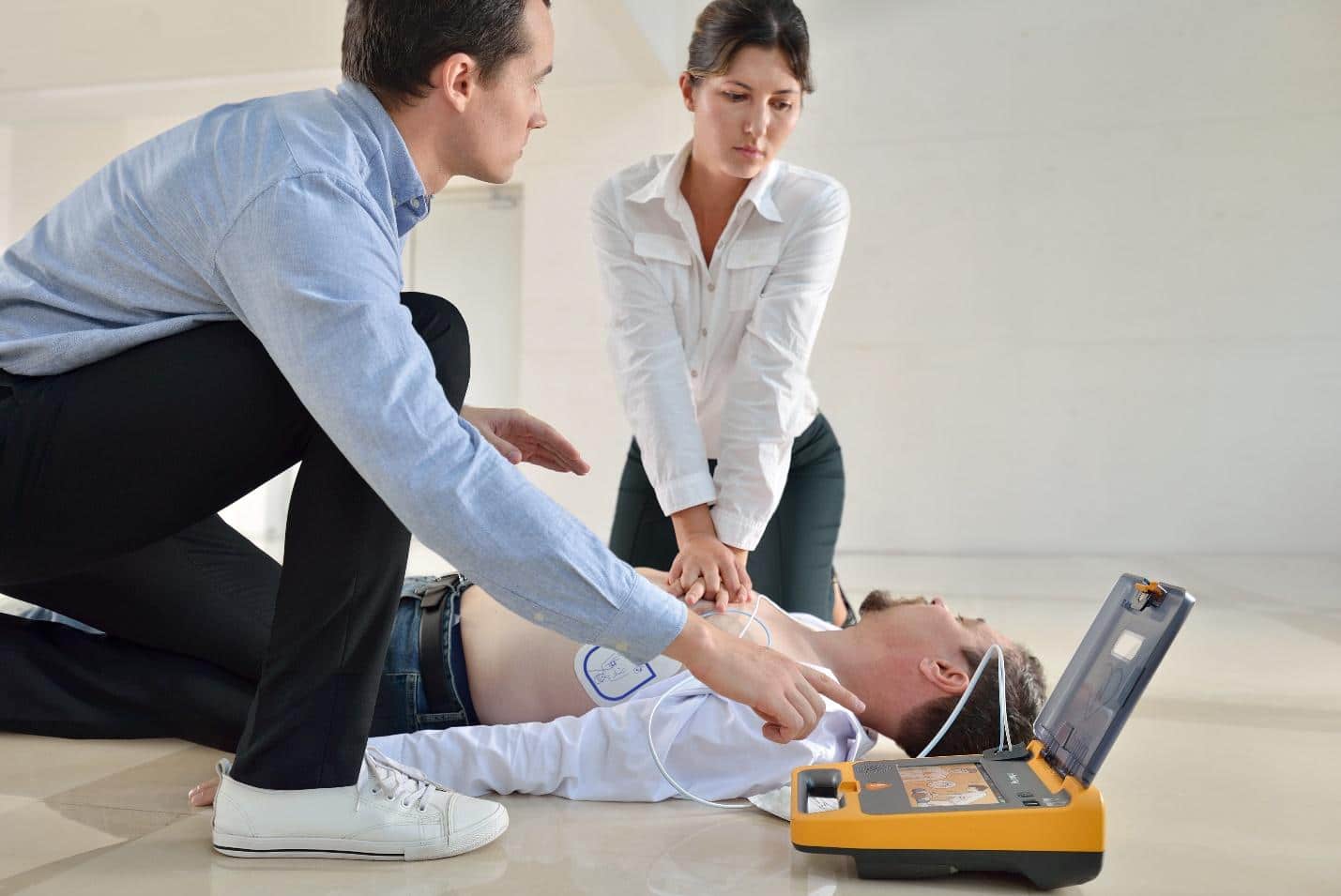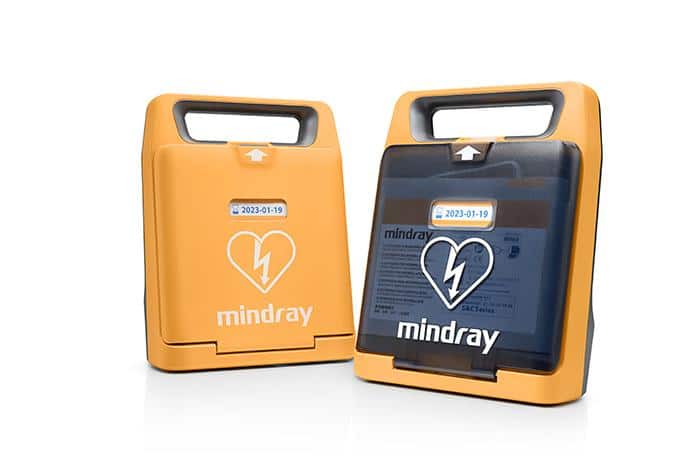How to Build an Efficient Resuscitation Team With AED Devices? – Sudden cardiac arrest (SCA) is a leading cause of death across the world. Over 30,000 people from Europe experience SCA accidents in public spaces[1] like malls, gyms, offices, and stadiums every year.
Unfortunately, most patients didn’t survive before even reaching the hospital.
That’s because most staff in these places lack efficient strategies to provide necessary care for cardiac resuscitation, thus reducing the survival rate of the victims.
Therefore, the need for businesses and organizations–irrespective of their sizes–to build resuscitation teams has been increasingly recognized. But how?
Let’s start by learning from the professionals. The professional rescue teams often comprise three members with assigned duties: a compressor (chest compressor executor), an AED devices operator, and an airway maintainer.
Considering these three members are indispensable and significant during a rescue event, it is suggested that each improvised rescue team shall likewise have at least three members to do similar work.
By working together, these members can provide instant care to the affected victim before the emergency medical service takes over.
As a result, they will boost the patient’s survival rate dramatically. So here comes another question: how does an improvised rescue team make magical changes in an emergency?
What are the Roles of a Professional Resuscitation Team?
A professional resuscitation team plays an important role in a successful resuscitation that requires well-organized assessments and treatments in a timely and effective manner.
The team’s primary goal is to revive the patient after sudden cardiac arrest by performing CPR using Automated External Defibrillators (AED devices).
Below is a detailed explanation of roles in the rescue team:
A Compressor (Chest Compressor Executor)
The member of the team handling compression knows and follows resuscitation guidelines and strategies to increase the victim’s chances of survival.
During rescue work for sudden cardiac attacks, Cardiopulmonary Resuscitation (CPR), which involves chest compressions and rescue breathing, is to help boost blood flow to vital organs such as the heart and brain while maintaining oxygen levels in the blood.
It should be noticed that compression quality could decide CPR quality, and CPR quality further leads to survival rate.
During the compression process, the team member will assess the patient, then initiate rescue work by doing chest compression and rescue breath. It is suggested that 30 compressions, followed by 2 rescue breaths, form a rescue cycle.
The compression executor shall apply adequate chest compressions at the right depth and rate (100-120 compressions per minute) to allow chest recoil.
The rescuers doing the compression often locate the center of the chest and push hard and fast to drive the heart to pump blood.
It is a tiring process in CPR, so the team member often swaps with another — usually the AED device operators — to combat exhaustion, normally every 2 minutes or 10 cycles.
AED Operator
As the name suggests, this resuscitation team member brings the AED devices to the scene (if one is not already present) and operates them.
The operator follows the AED’s instructions and places the electrode pads on the patient’s chest.
After that, the member presses the shock button to defibrillate the patient if necessary. In addition, an AED operator is the most likely candidate to alternate roles with the compressor.
Airway Maintainer
An airway maintainer handles everything about the patient’s airway.
This includes providing ventilation using a bag-valve mask or other apparatus and maintaining airway clearance during an SCA attack.
In addition, the individual can prepare and help with intubation, confirm endotracheal tube placement, and accompany the patient to tests and scans to manage the airway.
After every 30 compressions, the airway maintainer checks the airway to ensure it remains open and allows breathing.
This is important because when a person loses consciousness, the tongue, food, or foreign object can block the airway.
Airway management is vital during resuscitation. It helps reduce interruptions in chest compression, improves oxygen levels in the blood, and minimizes delays in defibrillation (if the first rhythm is shockable).
Roles of Modified Version of the Rescue Teams in Public Settings
Though the professional resuscitation team is really efficient in saving lives, it is impossible for the managers of public places to copy the whole model because of the lack of professional medical skills and technical devices.
But with some modifications to the three roles’ duties, it is possible to compose a practicable rescue team for public places. Here is the modified version:
- Compressor: This individual is trained to deliver quality chest compression during CPR. This team member accesses the patient’s condition and performs compressions to force the heart to pump blood to vital organs manually.
- AED operator: A team member skilled in safely applying and operating AED devices to access the patient’s heart rhythm during SCA events. The operator will bring in the AED device, place the pads, and execute external defibrillation.
- Order maintainer: A maintainer calls 911 during cardiac arrest and disperses the surrounding crowd to allow more fresh air for the patient, maintain the smooth rescuing process, and maintain the order in case the onlookers touch the victim when releasing electric shocks.
The difference between the professional and public versions of rescue teams boils down to the members.
In the public version of the rescue team, an order maintainer replaces the airway maintainer.
This change is important for a business setting since people tend to crowd around the victim when someone experiences a cardiac attack in public.
The member will not only disperse the crowd to create more space for the patient to access fresh air but also call 911 as the other members (compressor and AED operator) work to increase the survival chance of the victim before medical help arrives.
Conclusion
The average response time for medical professionals after a 911 call is about 8 minutes[2].
For each minute emergency CPR and AED are delayed, the victim’s survival rate reduces by 7-10%[3].
Luckily, businesses and public servants today can build modern rescue teams that use smart AEDs to provide immediate first aid.
Mindray is arguably one of the famous providers of professional smart AEDs in the market.
As a large enterprise covering more than 190 countries and areas, Mindray has a track record of offering high-quality AED devices in large quantities.
Mindray AED uses patented technologies such as ResQNaviTM, QShockTM, and 360J biphasic technologies to support both inexperienced and trained rescuers to perform their tasks more effectively.
From the above instructions, we can know that Mindray’s AED devices are efficient at carrying out SCA rescues.
They are good helpers in building an efficient resuscitation team by giving the members confidence in their rescue process.
References :
[1]. A prospective one month analysis of out-of-hospital cardiac arrest outcomes in 27 countries in Europe. Available at: https://pubmed.ncbi.nlm.nih.gov/27321577/ (Accessed: 29 June 2022)
[2]. News in basic life support and semi-automated external defibrillation. Available at: https://www.medintensiva.org/en-news-in-basic-life-support-articulo-S2173572711000075 (Accessed: 29 June 2022)
[3]. Recent advances and controversies in adult cardiopulmonary resuscitation. Available at: https://www.ncbi.nlm.nih.gov/pmc/articles/PMC2600120/ (Accessed: 29 June 2022).
Related CTN News:
Finding The Right Health Insurance Policy
How is Muscle Stimulator Device Used in Physical Therapy?
One More Person in the U.S. Dies After Contracting Monkeypox
⚠ Article Disclaimer
The above article is sponsored content any opinions expressed in this article are those of the author and not necessarily reflect the views of CTN News






